How do school bus cameras catch scofflaws? What we saw on a Yonkers bus ride along
YONKERS – Baltazar Velez eases his school bus out of the depot at the foot of Worth Street in the industrial center of Yonkers, where seemingly every inch of space that isn’t parked on is driven on. He taps the horn to warn drivers who might dart out of the alley where he has seen trucks emerge.
Velez is careful, a defensive driver. His bright eyes are in constant motion, his head's on a swivel. He has every type of city and suburban street awaiting him through his massive windshield. He has been taught to drive scanning the horizon, "looking to my future, 15 seconds ahead of me." He has seven mirrors to show him his immediate past and what is gaining on him.
He keeps 20 feet between him and the next vehicle. He calls it leaving himself "an out."
Velez’s horn is his friend and constant go-to, like when that Nissan tries to cut him off on Palmer Road. Or when that Chevy pickup makes an illegal U-Turn on Central Avenue, directly in Velez's path. A quick honk lets folks know he’s there.
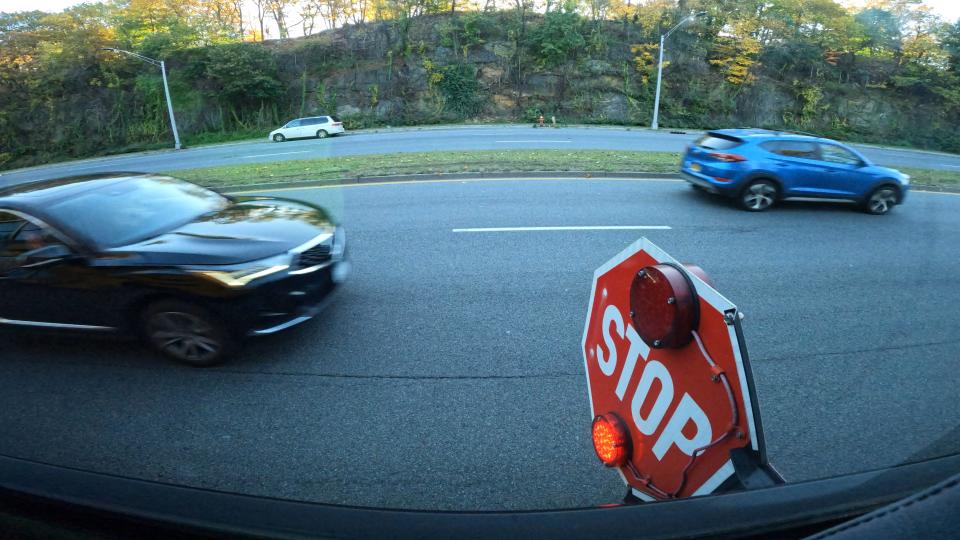
As if they could miss him.
His 10-foot-tall, 40-foot-long bright yellow bus can flash its lights in amber and red. If it weren't big enough already, at each stop he extends two flashing stop signs and a 10-foot-long arm to make sure kids stay clear of the front of the bus.
Missing the signs
But somehow, drivers sometimes miss all the flashing lights and signs and bright yellowness of Velez’s bus, and the hundreds of other school buses snaking their way through the city's streets. There are 524 bus routes on any given Yonkers school day, squiring 12,000 kids to and from school.
Sometimes drivers ignore the law, the one that requires traffic to stop when approaching a school bus with its red lights flashing and its stop arms extended. It’s the law everywhere. Including New York. Including Yonkers.
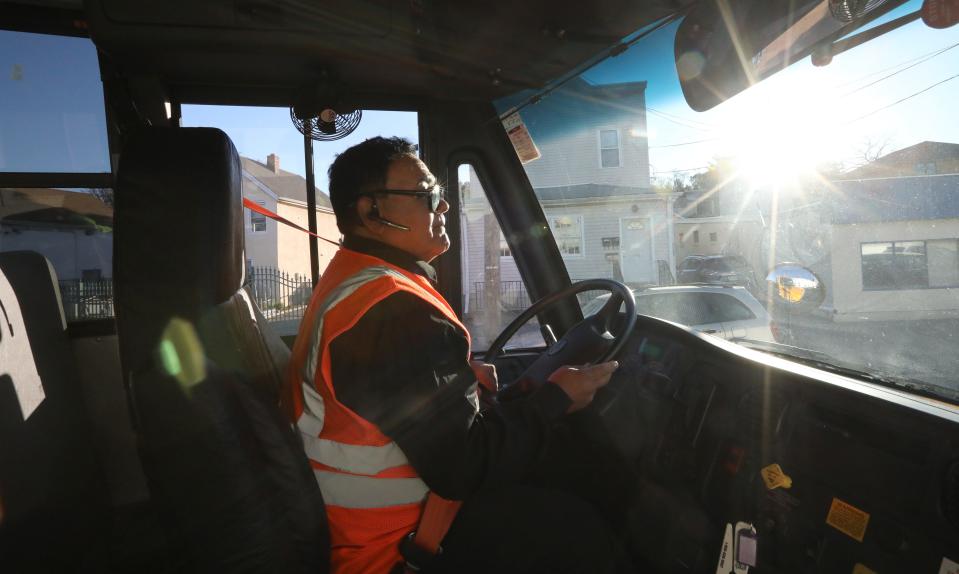
Which is why we’re here, riding along with Velez on the way to Casimir Pulaski K-8 school in the city’s northeast corner near the Scarsdale line.
We’re here to see people demonstrating their ignorance of the law, along with those who feel it doesn’t apply to them this bright fall morning because, well, they’re running late and they’ve got places to be.
The Governor's Traffic Safety Committee says 50,000 drivers pass stopped school buses every day in New York, putting schoolkids at risk every time.
We’re here because Velez’s bus and more than 300 others have been fitted with cameras to catch those who blow past stopped school buses. The cameras record them, the DMV identifies them, and the city — on Nov. 13, after a monthlong warning period — will start leveling hefty fines.
1,789 violations in just 20 days
Yonkers is joining municipalities across the state and the nation cracking down on bus-arm scofflaws, partnering with companies who install the cameras for free and split the revenues generated by the tickets. Most of the Yonkers fleet has cameras. The rest will be outfitted come January.
New York's bus camera law passed in 2019. It says the first violation for passing a stopped school bus costs $250. The next within 18 months, $275. A third, $300.
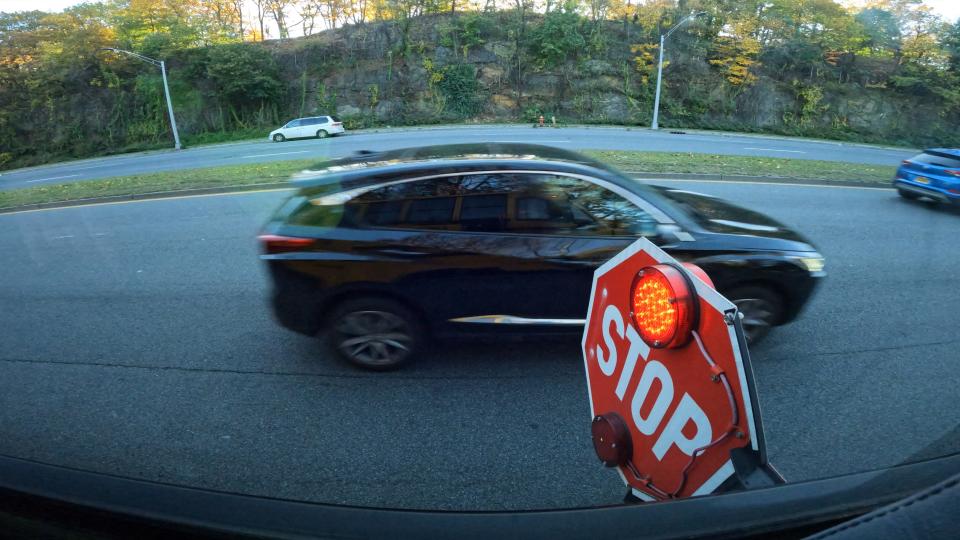
The program is called Yonkers Safe Stop, and it holds the promise of changing driver behavior, one ticket at a time, making city streets safer and generating serious money in the meantime.
In the first 20 days of the warning period, 1,789 notices were sent. Had those been violation notices and not warnings, they’d total $447,250, with half going to the city.
That’s $223,625 in 20 school days. If that pace were to keep up — $11,181 a day for 180 school days — the city could reap a $2,012,625 windfall.
Mayor Mike Spano said the goal is not to make money but to change behavior. He said he's not sure where that revenue will go, as it has been neither planned for nor budgeted. And it's a revenue stream he said isn't reliable. He thinks the number of violations will drop off as soon as the violations start hitting mailboxes, as it did when the city implemented red-light cameras years ago.
"This will be a campaign for people to stop doing it and if people stop doing it, we'll have very few people obviously getting tickets for it," Spano said. "Our goal is for us to have as few tickets as possible because the cameras will work."
How do the school bus cameras work?
The system uses the same technology as red-light cameras.
There are three cameras on each bus, mounted on the driver’s side. One is near the roof line at the back to catch the wide-angle view, two others are in a box of electronics in the bus’s midsection — one facing forward, the other back — to catch the license plates of offending cars.
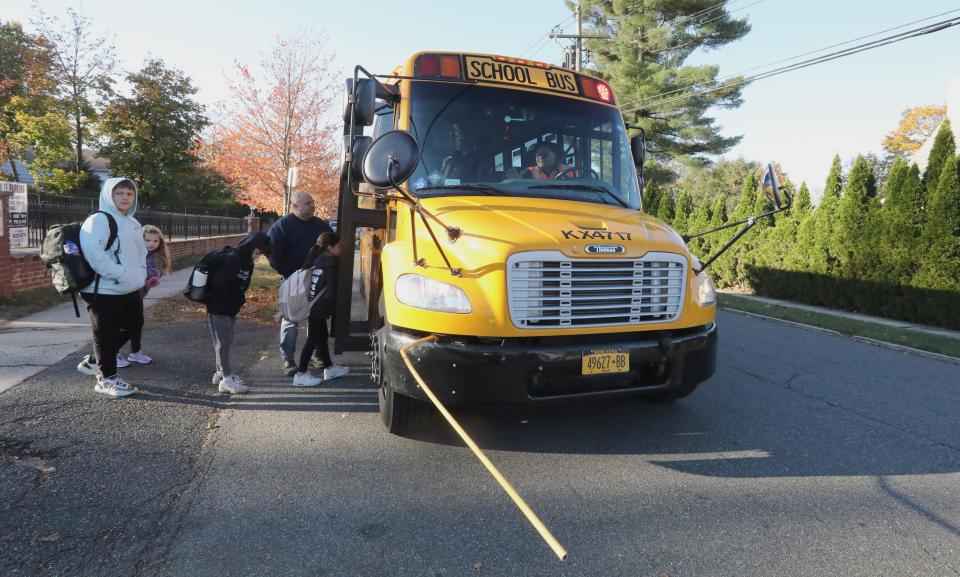
When the stop-arm is extended, the cameras engage and catch violators in the act.
The vendor — in Yonkers’ case, it’s Arizona-based Verra Mobility — reviews the footage, sends the license plates to the DMV to identify the vehicle’s owner, then forwards that information to the city’s parking violations bureau, which determines if there has been a violation and issues a ticket.
Police Commissioner Chris Sapienza is a fan of the technology, but stressed that it's not a case of an outside vendor doing police work.
“It's not the end-all, be-all, because at the end of the day, you need police enforcement and you need police involvement," Sapienza said. "You still have to sort through these tickets and to figure out which is actually a violation. We have to give people their due process.”
The cameras are a tool, the commissioner said.
“We can't be everywhere at once,” he said. “With these cameras, it's a force multiplier. It allows us to catch many violations that maybe we wouldn't. We catch a lot and we do our best to enforce, but these devices could actually catch many, many violators.”
Julio’s bus
Velez’s bus goes by many names. Its decal says it’s Bus 4717. A poster in the front passenger window identifies it as Bus #7 for Casimir Pulaski K-8 School. It’s also Route 6037. But the 10 students who’ll board this bus this morning know it as Julio’s bus.
Julio’s their regular driver, but he’s off today. With each stop, Velez learns that Julio typically rolls a bit later than the schedule that Velez is keeping to. The schedule says he's to be at the Reagan Townhouses at 1157 Central Park Ave. at 7:55 a.m., which is when he arrives.
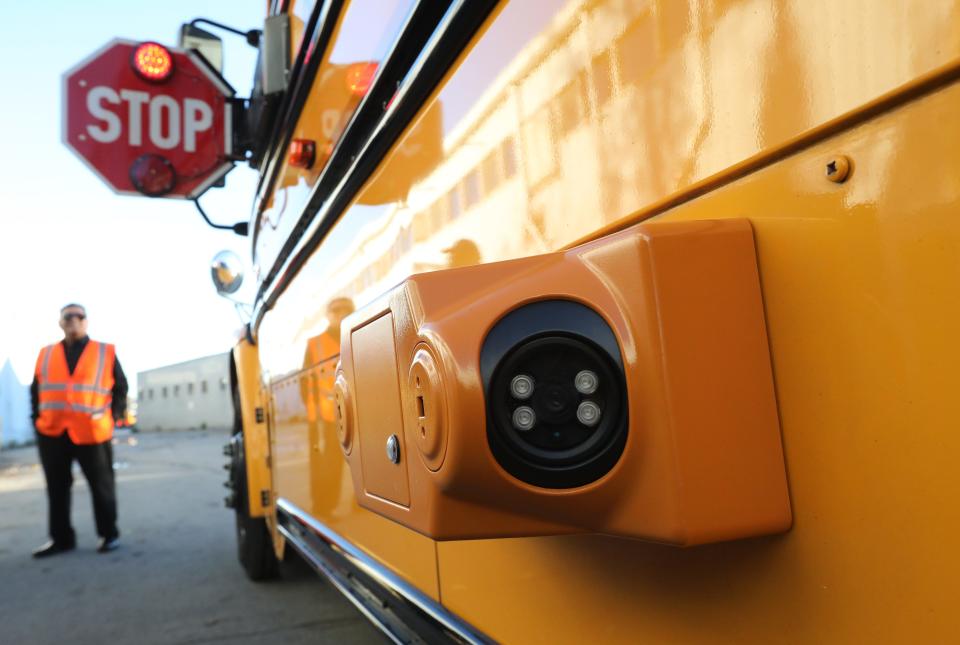
This is the stop where the camera data says to expect vehicles to pass the stopped bus. Central Avenue is busy.
The data doesn't lie.
About 300 feet before the stop, Velez flips the switch to set off the amber flashing lights, telling all drivers around him that he's nearing a stop.
"I tap lightly the brakes to let them know I'm going to stop," he says.
Sixteen cars pass in the lanes next to him as the lights flash yellow but before he comes to a complete stop and extends the stop arm. These drivers have broken no law, as the arm isn't out and the bus is not stopped.
When the flashing lights turn to red and the stop arm goes out, though, a small sedan speeds by, then two SUVs. They'll be getting warning letters. Then traffic stops behind him.
Velez opens the door to see a mother and daughter waiting.
"Pulaski?" he asks. They shake their heads. They're waiting for a different bus.
Meanwhile, across the grassy median, 16 cars continue speeding north on Central Avenue, oblivious to Velez's stop arm.
The DMV's driver's manual says that drivers in both directions must stop for a stopped school bus. It reads: "This law applies on all roadways in New York State. You must stop for a school bus even if it is on the opposite side of a divided highway."
Sapienza, asked if drivers on a divided highway would have to stop, said: "If you're talking about a center island or if you're talking about a double yellow line, then, yes, both directions. And this camera is sophisticated enough where it could actually pick up those vehicles up to four lanes away."
A cop's ticket can cost money and points
The Yonkers Safe Stop system generates data, showing Sapienza hot spots where he might dispatch squad cars to beef up enforcement. Yonkers Police officers will still write tickets for drivers who they observe passing stopped school buses.
There's a difference between those tickets written by officers and the violation notices that will be sent out starting today.
When a police officer writes a ticket for passing a stopped school bus, the ticket is issued to the driver, and the fines can range from a minimum of $250 to $1,000 for a repeated offense. A cop-issued ticket for passing a stopped school bus also will cost a driver five points on their license, and three offenses in three years could see their license revoked for a minimum of six months.
The camera system only tickets the vehicle, with no points.
A growing list
Yonkers is just the latest in a growing list of cities, towns and school districts adopting the technology.
There are two major vendors in the region, Virginia-based BusPatrol and Arizona-based Verra Mobility, which is the one Spano said was chosen by a committee of city staffers because it offered the best package. Vendors say the cameras cut the number of violations and educate the driving public.
Verra Mobility operates in 10 states and Washington, D.C., with 3,300 of their CrossingGuard cameras in operation in more than 50 sites. Its spokeswoman Valerie Schneider said that in the 2022-23 school year:
99% of drivers who got and paid a ticket for illegally passing a stopped school bus did not get a second ticket within the same school year;
71,386 violation notices were issued to drivers for passing a bus stop-arm;
Total citations dropped 12% from the start of the school year to the end;
Most stop-arm violations occurred on Wednesdays;
43% of violations happened between 3 and 5 p.m.
BusPatrol, meanwhile, operates in 16 states, with 25,000 buses nationwide, spokeswoman Kate Spree said.
Their cameras are in use on buses from Niagara Falls and Rochester to Hempstead and Glen Cove on Long Island. They’re in Orange and Dutchess counties, in Rensselaer and Albany.
In Rockland County, they’re on buses in Pearl River, Suffern, Nanuet, North Rockland, Clarkstown, Nyack, South Orangetown and East Ramapo. In Putnam, they're on buses in Mahopac and Brewster. BusPatrol is big on Long Island, too, with 5,000 of their cameras in use in 71 school districts across Suffolk County.
Back on the bus
The rest of Velez's run proves uneventful, beyond hearing at each stop that he's ahead of Julio time.
The route takes him to two more stops, onto narrow suburban residential streets, from Underhill Street to flag-lined Colonial Parkway North. He passes leaf-blowing landscapers and dog-walking seniors.
Velez picks up 10 students, well short of the usual 35. A cluster of girls chats excitedly about an upcoming dance-a-thon, and about how Julio helped a schoolmate who had fallen the day before.
When the bus arrives at Pulaski, Velez realizes why Julio tends to run a bit behind in the morning. There's a logjam along the school's sidewalk, the narrow street clogged with parked parents, with barely enough room for a car to pass between the line of buses and the cars parked in front of the neighbors' homes.
Kids and parents dart between the buses as the kids on Velez's bus wait for a woman with a walkie-talkie to give them the go-ahead to come off the bus. When they get the green light, Velez opens the door and sends them on their way with a mantra he repeats over and over: "Hold the handrail, watch your step, take your belongings with you, have a good day."
When they are all off, he does a safety check, walking to the back of the bus to ensure no child is still on the bus. He returns to the front, scanning each seat for forgotten belongings.
And then he points Julio's bus south.
It's 8:30 a.m., the school day is starting and all those yellow school buses are heading back to the hive of activity that is Worth Street, not unlike oversized yellow bees returning to the hive.
In a few hours, they'll repeat the process in reverse. And they'll have company again. And cameras catching it all.
Reach Peter D. Kramer at [email protected]. Support this kind of reporting with a subscription at www.lohud.com/subscribe.
This article originally appeared on Rockland/Westchester Journal News: Yonkers NY Safe Stop cracks down on drivers passing stopped school bus
